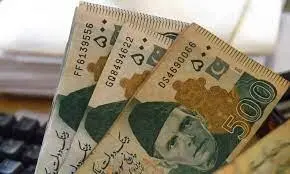The Pakistani rupee has made significant gains against the US dollar in recent weeks, appreciating by over Rs. 14 in just 12 sessions. The latest rupee-dollar rate, as quoted by the State Bank of Pakistan (SBP), is Rs. 299.50 per USD.
There are a number of factors that have contributed to the rupee’s recent appreciation. One factor is the increase in remittances from overseas Pakistanis. Remittances have been on a steady rise in recent months and reached a record high of $3.1 billion in August 2023. This increase in remittances has helped to boost the supply of US dollars in the domestic market and has contributed to the rupee’s appreciation.

Another factor that has supported the rupee is the improvement in the country’s foreign exchange reserves. The SBP’s foreign exchange reserves have increased by over $4 billion in the past year, and now stand at over $23 billion. This increase in reserves has given the SBP more firepower to intervene in the foreign exchange market and support the rupee.
In addition, the government has also taken a number of steps to support the rupee, such as imposing restrictions on imports and encouraging exports. These measures have helped to reduce the demand for US dollars in the domestic market, and have also contributed to the rupee’s appreciation.
The rupee’s recent appreciation is a positive development for the Pakistani economy. It will help to reduce the country’s import bill, and make exports more competitive. It will also help to improve investor sentiment and boost economic growth.
Impact of the rupee’s appreciation
The rupee’s appreciation against the US dollar will have a number of positive and negative impacts on the Pakistani economy.
On the positive side, the rupee’s appreciation will make imports cheaper, which will benefit consumers and businesses. It will also make exports more competitive, which will boost the economy’s growth. Additionally, the rupee’s appreciation will help to improve investor sentiment and attract more foreign investment.
On the negative side, the rupee’s appreciation will make remittances less valuable for overseas Pakistanis. It will also make it more expensive for Pakistani tourists to travel abroad. Additionally, the rupee’s appreciation could lead to inflation, as businesses may pass on the higher cost of imports to consumers.
What to expect going forward
It is difficult to say with certainty what to expect from the rupee in the coming months. However, there are a number of factors that could support the rupee’s appreciation, such as continued growth in remittances and foreign exchange reserves. Additionally, the government’s efforts to support the rupee are likely to continue to have a positive impact.
However, there are also a number of factors that could weigh on the rupee, such as an increase in imports or a decline in exports. Additionally, the global economic outlook is uncertain, and a slowdown in the global economy could have a negative impact on the rupee.
Overall, the rupee’s outlook is positive in the short term. However, investors and businesses should be aware of the potential risks that could weigh on the rupee in the medium to long term.
How to protect yourself from the rupee’s volatility
The rupee’s volatility can pose a number of risks to individuals and businesses. For example, individuals who receive remittances from overseas Pakistanis may see the value of their remittances decline if the rupee depreciates. Additionally, businesses that import goods or services may see their costs increase if the rupee depreciates.
There are a number of things that individuals and businesses can do to protect themselves from the rupee’s volatility. One option is to hedge their exposure to the rupee. This can be done by entering into contracts with banks or other financial institutions that will protect them from losses in the event that the rupee depreciates.
Another option is to diversify their assets. This means investing in a variety of currencies and asset classes. By diversifying their assets, individuals and businesses can reduce their risk exposure to the rupee.
Finally, individuals and businesses should also be aware of the risks associated with the rupee’s volatility when making financial decisions. For example, individuals may want to consider delaying large purchases if they expect the rupee to depreciate in the near future. Businesses may also want to consider hedging their exposure to the rupee when entering into contracts with foreign suppliers or customers.
Conclusion
The Pakistani rupee has made significant gains against the US dollar in recent weeks. There are a number of factors that have contributed to the rupee’s appreciation, such as the increase in remittances from overseas Pakistanis and the improvement in the country’s foreign exchange reserves. The rupee’s appreciation is a positive development for the Pakistani economy.
Job Openings in Saudi Arabia with Kitopi, Paying Up to 9,000
